Schisandra - magnolia vine
 Magnolia Vines are climbers native to Asia and North America. They currently belong to the Schisandraceae family, but used to be assigned to family Magnoliaceae, since they share many characteristics with magnolias - structure of flowers, fruit and fructifications.
Magnolia Vines are climbers native to Asia and North America. They currently belong to the Schisandraceae family, but used to be assigned to family Magnoliaceae, since they share many characteristics with magnolias - structure of flowers, fruit and fructifications.
This is still reflected in its common name, Magnolia Vine. In Poland there are three species of Magnolia Vine in sale: Schisandra chinensis, Schisandra henryi and Schisandra rubriflora.
 Schisandra chinensis (photo Sz. Marczynski) Schisandra chinensis (photo Sz. Marczynski) |
Schisandra chinensis - Chinese Magnolia Vine
Schisandra chinensis is a valuable climber native to China and Korea, grown for ornamental and medicinal purposes as well as for consumption.
It has handsome elliptic or oval deep green leaves with red petioles. In autumn the leaves change colour to yellow. The stems are brown, reach 10 m (1 m of new growth a year) and can either twine round the support or spread along the ground.
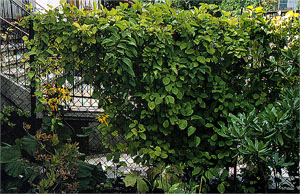 Schisandra chinensis (photo Sz. Marczynski) |
Magnolia vine is most often a monoecious plant e.g. it has both male and female flowers on each individual plant. You may sometimes encounter dioecious specimens of Schisandra chinensis, that is, the plants with only female or male flowers. The flowers are small, white, creamy or pink and appear at the turn of May and June. The fruits ripen from mid August to mid September and are bright red berries gathered in grape-like clusters.
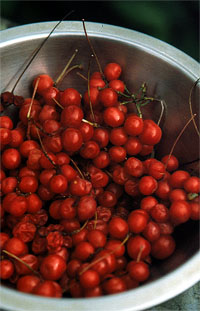 Schisandra chinensis - fruit (photo Sz. Marczynski) |
Requirements.
It requires fertile and moist, but not damp soils. It grows best and produces best fruit in a well-lit position, but sheltered from direct strong sunlight, so the best are northwest- and northeast-facing , sheltered sites. Chinese Magnolia Vine is a frost hardy plant sustaining temperatures down to -30oC and sometimes even down to -40oC (zones 5A-8).
Planting and culture.
It can be planted at any time of the growing season. Plant it into a large pit, provide good drainage and lay the bottom with manure, analogically as when planting clematis. During the first 2-3 years it's best left to grow in an unrestrained manner. Afterwards, choose between 1 and 3 the strongest stems and tie them up to a support to make them grow vertically. The stems that spread over the ground produce neither flowers nor fruit. Every year in early spring, before the beginning of the growing season, prune the plants to remove all weak and ill stems and cut last year’s stems just above the 12th-15th well developed bud. Remember to water regularly and abundantly as Chinese Magnolia Vine isn’t tolerant of drought. Start fertilizing it in the second year after planting. Line the base of the plant with well spread manure and cover it with a 2 cm layer of composted bark. A correctly trained plant will start bearing fruit in the fourth-sixth year after planting. One bush will yield from 1 to 5 kilos of berries.
Application.
Suitable for growing up fences, walls, pergolas and the special T-shaped supports, similarly to actinidias.
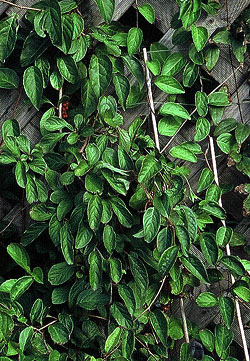 Schisandra chinensis on a fence (photo Sz. Marczynski) |
The fruit are the main attraction of Chinese Magnolia Vine. They contain schisandrine (tonifying and strengthening substance), vitamin E and easily assimilated microelements: iron, copper, manganese, nickel, molybdenum, titanium and zinc, as well as being high in magnesium, potassium, and phosphorus. Fruit can be eaten raw or processed e.g. it may be dried or made into juice, extract, infusion or liqueur. Schisandrine and other substances of medicinal properties are present also in bark, leaves and seeds. An infusion made from dried leaves, resembling in taste lemon green tea, invigorates and tones up the nervous and respiratory systems. Chinese Magnolia Vine preparations are used to combat physical and mental fatigue, drowsiness, exhaustion, depression, anemia, lung, liver and digestive system diseases and poor visual acuity. It should not be used in case of nervous hyperactivity, insomnia, hypertension and heart diseases. In the Far East, besides ginseng, schisandra is the most popular herbal drugs. The Chinese name of Schisandra chinensis is "wu-wei-zi", which literally means "five flavor berry", which comes from the fact that its berries possess all five basic flavours: the outer shell is sweet, the flesh sour, the seeds bitter and tart, whereas magnolia vine's extract tends to be salty.
Schisandra rubriflora
Schisandra rubriflora is still a little known climber but worth recommending to all plant lovers owing to its intriguing deep red flowers opening in April-May. It’s a bisexual plant and only male plants with small (about 2,5 cm across) but quite conspicuous deep red flowers borne single on long stalks in leaf axils are encountered for sale. Schisandra rubriflora climbs by means of twining reddish stems and attains the height of 3-4 m, producing about 1 m of new growth in a year. Wide lanceolate green leaves.
Requirements.
It thrives in fertile moist but not waterlogged soil, sheltered from strong wind and midday sun. It’s generally healthy, rarely attacked by diseases and pests. However, it isn’t very hardy and can only by cultivated in a mild climate (zones 6B-9).
Application.
It’s best planted in a quiet spot, next to a wall or any other garden support, close to a path, a door or a gate, so that its lovely intensely deep red flowers with contrasting pale yellow pollen can be admired from close up.
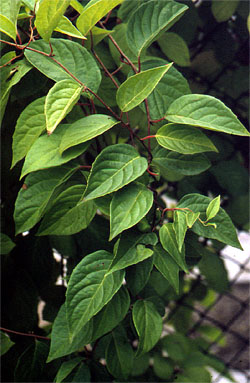 Schisandra chinensis - leaves (photo Sz. Marczynski) |
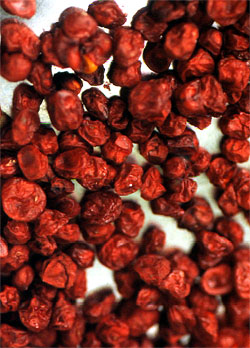 Schisandra chinensis - fruit (photo Sz. Marczynski) |
